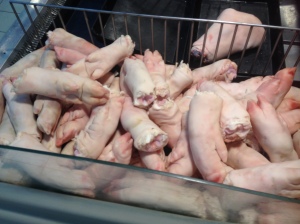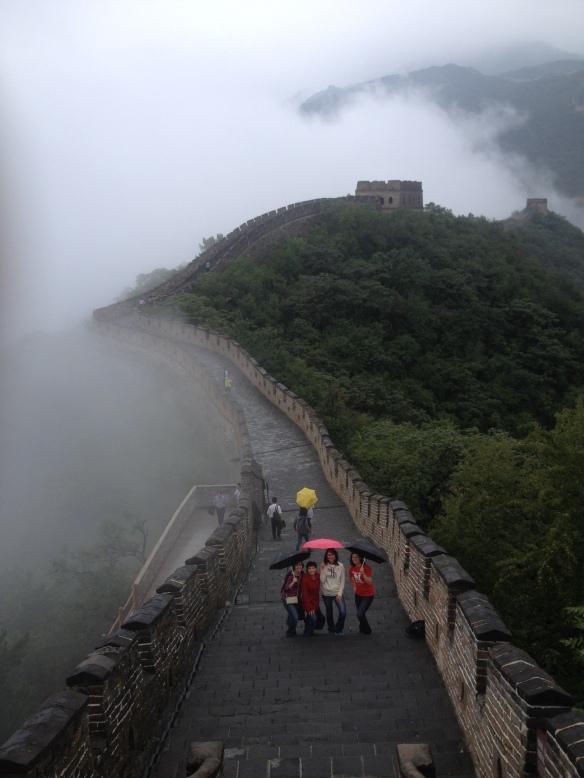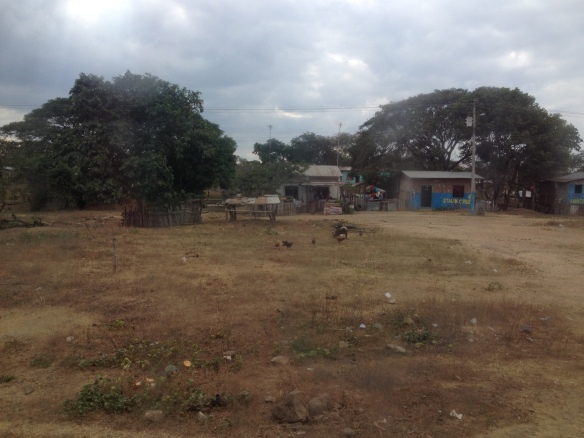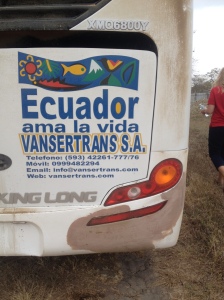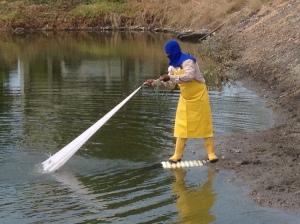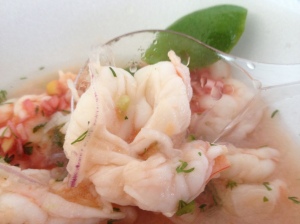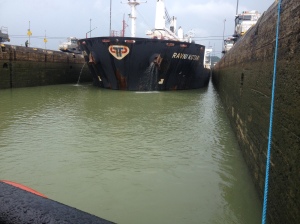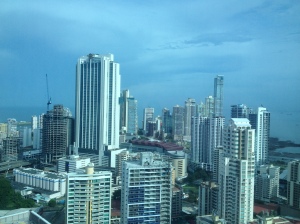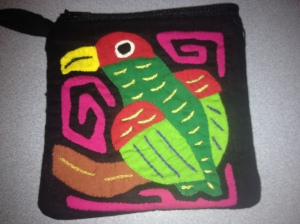Beijing, China – Part 5 – Corn Harvest
I recently had the opportunity to travel to Beijing, China with USSEC (United States Soybean Export Council).
We were mostly in Beijing, but one day we did travel outside the city to visit the Great Wall. Along our drive to the Great Wall, we did see some corn that had been harvested along the side of the road. The kernels were still on the cobs, and the entire ear was drying down. It was covered in plastic that day as it had been raining lightly throughout the day.
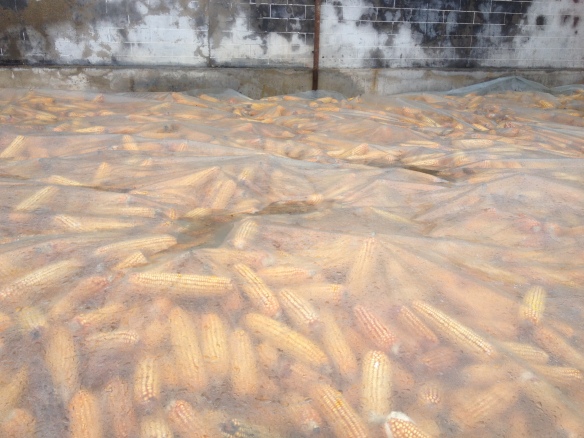
Recently harvested corn, just outside Beijing, China. Notice the corn kernels are still on the cobs.
On the return flight home, I sat next to a man who worked for a large agribusiness company. He told me that the farmers in China will harvest corn at the half milk line stage which is much earlier than when the U.S. farmer would harvest. He said that the average corn yield in China is 80 bushels per acre (similar to where the U.S. was in the early 1980’s).
You’ll notice in the picture that the corn kernels have not been removed from the cobs. He said that they will allow the corn to dry down on the cobs then some sort of machine will come through and remove the kernels from the ears. The kernels will eventually be picked up and the cobs will be burned as fuel for the family’s fire during the cold months.
I would love to see a Chinese farm and harvest first hand!
Comparison to U.S. Farm
As a comparison, if the average farm in China is 2.5 acres (like 2 ½ football fields), and corn yields 80 bushels per acres, their total production would be 200 bushels of corn. Today the U.S. price of corn is $3.50, so they would yield $700 total for their crop, and entire livelihood for the year!
The average U.S. farm is 446 acres. This size of a farm requires at least one spouse (likely both) to work off the farm to support family living expenses and provide benefits, such as health insurance.
While we were traveling, we were told a few different times that the term farmer is equal to peasant in China. It’s fascinating to look at the contrast between U.S. and China’s farming styles. It makes me very thankful for the technology and innovations that we have available to us on our farm. It also reminds me of the plight that other farmers have who don’t have access as we do.
Beijing, China – Part 4 – China & US Grain Markets
As you may know, professionally, I have worked with farmers for many years on helping them to market (sell) their grain. It’s next to impossible to think about the grain markets and not think about the impact that China has.
China and the U.S. are very important to one another in agriculture.
China’s Population
The reason that China influences the U.S. markets so much is because they have such a large population to feed. China’s population is nearly 20% of the world population. It really is something to think about those numbers from a remote town in Kansas, and quite another thing to see it first hand in Beijing, China.
With this mass quantity of people, food security is one of the top priorities. From a very simplistic view, keeping people fed helps tremendously in keeping peace. This was my basic understanding prior to my trip, but as with most things, it’s much more complex than this basic assumption.
Movement of people from rural to urban areas
Because the rural areas are very poor and because it’s difficult to provide services to remove areas, the Chinese government has a goal to encourage people to move from the rural areas of China into the cities. The plan is to move 25% of the rural population to the urban areas over the next several years. Think about this – this is like moving the entire population currently located on East Coast to the Midwest!
The thought process is that if the people are in urban rather than remote areas than better services can be offered such as nutrition and education. Along with moving into the urban areas is improved incomes. This is not unlike the migration from farms to the cities that the US witnessed during the 1920’s to the 1950’s. The first thing that comes along with higher incomes is higher quality nutrition, almost always first in the form of protein. This is why there has been a dramatic increase in the consumption of pork and chicken in China over the past decade. Pork and chicken are both large consumers of soymeal in their feed (food) ration.
Impact on U.S. Farmers
China is a very important buyer of U.S. grains, and particularly U.S. soy. China is the fourth largest producer of soybeans in the world. Yet, the Chinese consume so much soy that twenty-five to thirty percent of the entire U.S. soybean crop is exported to China.
When they encounter dry growing conditions, such as they did the past few years, they can purchase mass quantities of other grains from the U.S. and other countries, as well.
China’s largest agriculture export to the U.S. is aquaculture.
Chinese Farms
Farms in China are about 2.5 acres each (or 2 ½ football fields). The majority of the farm work is manual with very few farms having mechanization. Because of steep terrain, some of the farmland would be quite difficult to farm by machine.
There are no personal property rights in China. The government owns the land and the tenant farmers have long-term leases of 30 years. As I understand it, the one who has the land leased is allowed to sublet the land to another.
Not Enough Farm Land
There is not enough farm land in China to produce all the food needed to feed their people. They look at wheat and rice as being staple foods to feed the people, so the government allocates enough acres to be mostly self sufficient in wheat and rice production. Then there are enough acres left to be mostly self sufficient in either corn or soybeans. Looking at the tonnage of production per acre of each of these crops, it makes more sense for them to try to be self sufficient in corn. They look at it as importing land and water and saving on freight by importing soybeans. Another advantage to importing soybeans is that there are reliable suppliers in both North and South America and differing growing seasons.
Soy foods are commonly eaten in China. My understanding is that all the soy foods consumed are grown in China and is non-GMO. However, with the population and the increase in future incomes, eventually, they may need to import soybeans for food as well as feed.
GMO Concerns
Although the internet is different than it is in the U.S. with many popular U.S. websites blocked, the Chinese people certainly have access to their own sites on the internet. Similar to the U.S., they also have celebrities and bloggers who help mold the opinions of the people. With that, people in China have heard many of the same concerns around GMO (genetically modified organisms) production that we see in the U.S.
The people are very health conscious. They want to know what the long-term impacts of eating GMO foods are. They have concerns about whether or not GMOs cause cancer, infertility issues, or allergies.
Why I was in China
I was one of four U.S. farm moms who went to China. We met primarily with younger women to discuss how and why we raise GMO crops on our farms. We talked about what U.S. farms are like. We also shared about why we feel that GMO crops are safe to consume and how GMOs have helped our farms and by extension have helped the environment. We also talked about some of the things that we think will be important in the future with GMOs. Below are a few good websites on the safety of GMOs.
In a future blog post, I will address some of the common concerns about GMOs – stay tuned!
Resources for GMOs
GMO Answers http://gmoanswers.com/
CommonGround http://findourcommonground.com/food-facts/gmo-foods/
Best Food Facts http://www.bestfoodfacts.org/
Beijing, China – Part 3 – The Food
The food was wonderful! Admittedly, we were probably sheltered from some of the most customary foods. For example, they consider China to be complementary in the meat cuts, meaning that they prefer the parts that we don’t. I saw many pig and chicken feet at markets (although I did not try them).
I did learn to eat with chopsticks on the fly. I’ve always eaten with a fork, but while there – one must learn! I was definitely a slow eater though. At all the restaurants that we ate at had round tables with a lazy Susan in the middle. The dishes were served family style, and everyone served themselves a little bit of each.
My favorite dish was a mandarin fish with sweet and sour, but it wasn’t anything like the sweet and sour I’ve eaten in America. It was delish! The food differences that I noticed were a lot more vegetables, not much grain (honestly we didn’t even eat much rice), and we only had dessert twice. The famous Peking duck dish is just something one has to try while in China. It was very good!
We had the opportunity to visit a large store, Carrefour, and walk through the grocery area. It was fascinating, and struck me to see how much fresh produce there was. I would say the produce area was about five times larger than the local Kroger store that I frequent. The reason for that much bigger produce area is likely because of the mass quantity of people shopping at this store (Beijing is 20 million people) plus they seem to eat more vegetables than we tend to in the U.S.
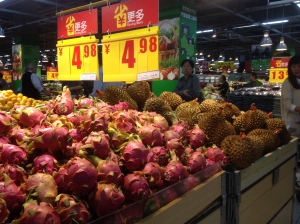
Some of the produce was very different.
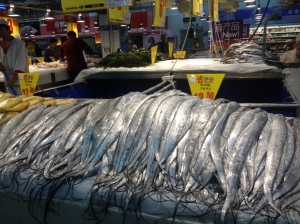
Fresh fish. It was different for me to see it available in bulk rather than packaged.
Secondly, I noticed that a lot of food was in bulk and not packaged. For example, the rice you just grabbed a scoop and bagged however much rice you wanted. The meat was also in bulk and not individually wrapped. I wonder about some food safety issues with having food in bulk that people are helping themselves to, but I suppose if that’s what your grocery was like, you’d get used to it.
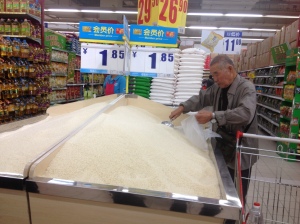
Bulk Rice
Lastly, the staple products were a little different than we have. Similar to how we have a cereal aisle, and they had an aisle for oil. Oil is considered a staple as they cook with it on a daily basis.
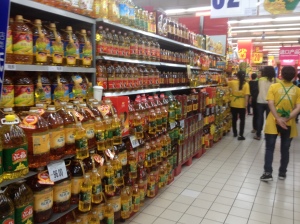
Look at the oil aisle! So many choices.
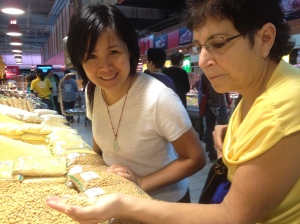
Soybeans can be purchased in the grocery store – either bulk or packaged in bags.
When soybeans are crushed, the old is extracted to make vegetable oil and the soymeal that is left is fed to livestock in a feed ration. The Chinese population regularly eat soy in their diets. Although the soy that they eat mostly is grown in China.
Since I was traveling on behalf of U.S. soy, we did order tofu at most meals. We eat edamame regularly in our house, but I am looking forward to learning how to incorporate other forms of soy into our diets as I learn to cook with them.
From our own farm raised soybeans, I have picked green soybeans around Labor Day and steamed them like edamame and have roasted the mature soybeans. I’m looking forward to playing around in my kitchen to learn how to incorporate tofu and tempeh into my cooking.
Beijing, China – Part 2 – Cultural Immersion
While in Beijing, China, we were very fortunate to see a few of the famous sights. Seeing these sights and gaining an understanding of their importance was very helpful to understanding the people and culture.
Really, how can you go to China and not see the Great Wall? It is no wonder it is one of the great wonders of the world. It’s absolutely amazing to think how this structure was built during the Ming Dynasty. The terrain where we were was rough. We took a gondola to the top. It was overcast and misty the day that we were there but what a sight it is! If you’ve seen opening scene in the Disney movie, Mulan, that’s kind of what it’s like. Every couple hundred yards there is a shelter with a lookout tower with a walkway continuously connecting the entire wall. The walls for the shelters were at least one foot wide. The section that we visited was built in the 1400’s.
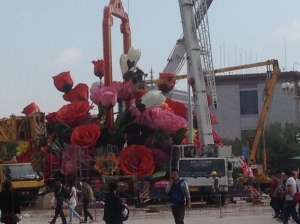
At Tiananmen Square – this was a beautiful display being constructed for National Holiday.
Our second big sight to see was Tiananmen Square and the Forbidden City palaces. We were there the week before National Day so there was a lot of preparation going on in Tiananmen Square. National Day is October 1-7, and people gather in Tiananmen Square to celebrate and see government officials during the celebration. The Forbidden Palace was built during the Ming Dynasty. It is called the Forbidden City because no one could enter or leave without the emperor’s permission. There are several gates. The structures were very elaborate and housed the emperor’s administrative offices and as you go deeper into the gates. Near the back of the palace you approach the family quarters including the concubine quarters and family gardens.
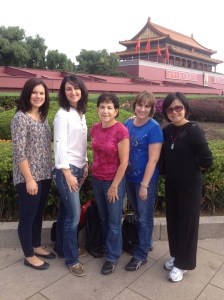
The four farm moms and our translator in front of entrance to Forbidden Palace.
We also had the chance to do some shopping at the Silk Market and the Pearl Market. Shopping is different from the U.S. as you barter. Of course, you also have to consider the exchange rate of the currency to as well.
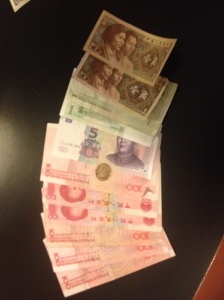
This was the equivalent of $200 US.
Contrary to U.S. shops, when the markets are closing, they don’t have a lot of incentive to close up shop. They seem to look at it as the opportunity to lock in a few more sales. The salespeople seemed to get a little more aggressive and started lower on prices. I like to negotiate so I thought shopping there was a lot of fun. However, I had to remember that I had jet lag and since they barter all the time, they are much better at it than I ever will be! Just got to be willing to walk away. Jade, pearls, and silk are the more popular items to buy. I came home with gifts of fans, silk cuts which is a traditional art, a tea set, and silk scarf. A couple of the ladies that I traveled with had blazers custom made for them, perhaps if I ever go back, I’ll do that too.

The silk market. The fabric was beautiful!
We were so fortunate to have a wonderful lady, Jane, who traveled with us. She was our translator, but also ended up being a tour guide and really helped us to have a better understanding of the people. Jane was raised in Shanghei, but has lived in the U.S. for several years. Jane was wonderful!
Jane bought this instrument for her 6 year old son. You can watch this YouTube video to listen to what it sounds like. It’s beautiful!
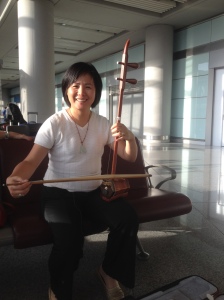
Having the opportunity to be among the people was very helpful in understanding some of the issues that the people face. It’s a fascinating ancient culture.
Beijing, China – Part 1 – The People
Although I am very new to any sort of world travel, I think people always tell the story no matter where one is at. People are people, and each individual makes the difference. I found the people of China to be very friendly. Customs and tradition are very important in their culture. Exchanging business cards was almost ceremonial.
The population is large. The Chinese people make up about 20% of the world’s population. Beijing is nearly 20 million people which is like New York City’s population times two plus Los Angeles. For math lovers Beijing = 2NYC + LA.
When we arrived at the airport in Beijing, one of the first things we did was get on the shuttle. The shuttle was packed. By packed, I mean it was well beyond the capacity for American standards. The reality is that there are so many people that personal space isn’t something that people worry about much because you don’t have the luxury of room. For example, when we were waiting to get into Tiananmen Square, people just pushed in on each other in hopes to get to the front. It was a little nerve wrecking for us as we are used to Disney style lines rather than masses pushing up against one another. Simply a cultural difference.
Another difference is that tipping is not customary. This was strange to me because I really wanted to tip. Especially when five of us got a foot massage.
Lessons Learned While Getting a Foot Massage
The foot massage lasted about an hour. While our feet were soaking, they massaged our backs. I had been carrying a cross body purse and my shoulder was particularly sore. This massage was a very deep tissue massage, and my muscles were very extremely tender the next day. After our backs, they proceeded to massage our feet and lower legs.
The masseuses did not speak English, but we had a translator with us who would tell us what they said. At one particularly painful point on my foot, my masseuse told me that I wasn’t sleeping well. Yes, she was right, jet lag did not agree with me as I probably averaged only 3-4 hours of sleep per night! She also told me that my back was bothering me. It was amazing what she could tell from my feet!
The foot massage, although a little painful, was a neat experience. However, what really struck me was when they told our translator that most of them were from the rural areas and most had children that were being raised by their parents as they work in the city, send money home, and rarely have a day off to go home. As a mother, it was heartbreaking to think of them not seeing their children regularly.
Their stories reminded me of the news reports that I’ve seen on the people who make iPhones. I suppose in many cultures there is the generation that leaves the family to gain better employment to move the family into a higher income level. Although this may be necessary, it’s heartbreaking to imagine what that does to each of the people in that family. I easily would have tipped her 100% for the massage if I would have been sure it would have helped her family, but it was uncertain that she would get and be able to keep the money.
Movement of people from rural to urban to areas
There is a goal to move more of the rural population from the rural areas into urban regions over the next several years. The rural areas are very poor and it’s difficult to provide services such as medical and education. People consume about half as much food in the rural areas compared to the urban population. The goal is to get people moved into the urban areas where there are better jobs and services. With the better jobs then they can afford and have access to more food. Whenever people improve their incomes, they improve their diets including more protein. If you think about this goal in terms of the U.S. population, it would be like moving the entire East Coast population to the Midwest!
Importance of education
Along with the goal to move a portion of the rural population is to provide better education to the people. Education is very important in China. We were told that Kindergarten in China is from age 3 to age 5 years old. I understood that beyond primary education, the family pays for their child’s education. It’s quite competitive to get into the best upper level schools, and they are very expensive.
One child rule
The most common question people have asked me about China is if the one child rule still is in force. As a means to control the growth of the population, in the 1970s the Chinese government implemented a rule that each family was allowed to have just one child. I understood that there might be some differences among the requirements depending upon the providence that the family lives in. The government has relaxed the one child rule, if each parent is from a one child family, then they are allowed to have two children. In some regions, if at least one parent is from a one child family, they may be able to have two children. However, we were told that because education is so important, and the best education is so expensive that many families continue to choose to have only one child.
I am so glad that I had the opportunity to travel to China, and be immersed for a few days in their culture. It was a wonderful experience to meet the people, hear some of their stories, and clear up some of the misconceptions that I had about their culture. It never ceases to amaze me that when I’ve had the opportunity to talk with another how much understanding we can gain from one another.
I recently had the opportunity to participate in the USB (United Soybean Board) 2014 See for Yourself Program. The See for Yourself Program allowed participants to see how U.S. soy is used throughout the world. On our tour we had the opportunity to visit Panama and Ecuador.
The People of Ecuador and First World Problems – Part 5
One thing that was solidified in my mind on this trip was how complex the world food system truly is. The food system is complex because there are more than 7 billion people on this planet that need to eat. How do we get enough food to all the people who need to eat? Who are the most efficient at producing and transporting food to people?
The complexity was driven home to me most in seeing the chicken farm that we visited. What struck me is how the people were paid daily. Therefore, every day they need to shop for their food. Chicken is the highest per capita meat eaten. The people go to the market daily, if their choice that day is for chicken. They buy a live chicken, take it home to butcher it themselves, and prepare it for their family.
By contrast, in my world, I make a meal plan each week, and buy the groceries that I need to supplement what is already in my pantry and freezer. If one of my meals has chicken in it, likely, I just purchase the parts I want (honestly, I can’t remember the last time I bought an entire chicken!). Then as the week goes on, I may or may not make that recipe. Perhaps I’m too busy and I choose to order pizza instead on the evening I was going to make that recipe. Oh, first world problems!
My family’s farm is primarily produces corn and soybeans. These are not grains that we readily consume as humans. How our farm fits into the food chain is that most of our soybeans go to a soy crusher where the oil is extracted from the soybean to produce vegetable oil and the meal that is left is fed to livestock as a high energy and protein source. In our area, most of the soymeal goes to feed either poultry or pigs. Our corn either goes into feed for cattle, pigs, or poultry. {See my blog from September 21, 2012, Where Does All That Grain Go? for details of where the grain from our farm goes once it’s harvested.}
In Ecuador, we were able to meet with several customers who buy U.S. soy which is mostly to be fed in a ration (AKA recipe) to chickens, pigs, or shrimp. Chickens and pigs provide an important protein source for the people. I don’t know how many of the people regularly eat shrimp, but I know from the farms we toured that each provided valuable jobs to the people.
I was interested to understand the economic benefit of the businesses we were visiting. Of the businesses we visited, they employed about 6,500 people. Obviously, the ports handle more than just agriculture products, but it was interesting to me to see how important these jobs are to the people and how agriculture plays a major role in all of these jobs.
I hope that you have enjoyed reading about my travels to Panama and Ecuador as much as I’ve enjoyed sharing my observations. I feel like this was a once in a lifetime opportunity for me to see in depth how U.S. agriculture impacts the world. I’m very appreciative to the United Soybean Board for allowing me the opportunity to see for myself how U.S. soy is used in other countries.
Ecuador – Chicken & Pigs, oh my! – Part 4
The last couple days in Ecuador were spent in the mountainous region of Quito. In this part of the country, we learned more about the importance of chicken and pork to the people’s diets.

Quito is in the mountainous area of Ecuador. This picture was taken from the airplane. Landing was interesting, it felt more like the plane was fishtailing rather than turbulence. I wasn’t the only one on the plane that was a little nervous.
Chicken production in Ecuador is very important, as chicken is the most consumed meat per person. We had the opportunity to visit a broiler production farm and a meat processing facility that integrated to raise chickens as well.
An interesting contrast to U.S. employees is that many Ecuadorian workers are paid daily rather than weekly or monthly (I think this is mostly true for lower wage employees). Receiving their wages daily, most people buy their food on a daily basis. It’s not unusual for them to purchase a live chicken to take home to cook for the evening meal.
The broiler production farm that we visited, raise 400,000 chickens per week. Of these, over one-third of the chickens were sold retail to individuals. I wish I would have gotten a picture of it, but we met several trucks that looked similar to older 10 wheel trucks that had high side boards. Inside the bed of the truck were crates which were stacked one upon the other transporting live chickens to go to the market for families to buy.
This farm said that they use about 30% of soymeal in their feed rations for their chickens, and they have a preference for U.S. soymeal because of the amino acid levels. Listen to this interview with Brownfield Ag here.
Everywhere we drove we saw small store fronts along the roadside. All of them had bananas hanging along with other food. We stopped at one storefront and were able to walk around. The store was about the same size as a large master bathroom – very small!
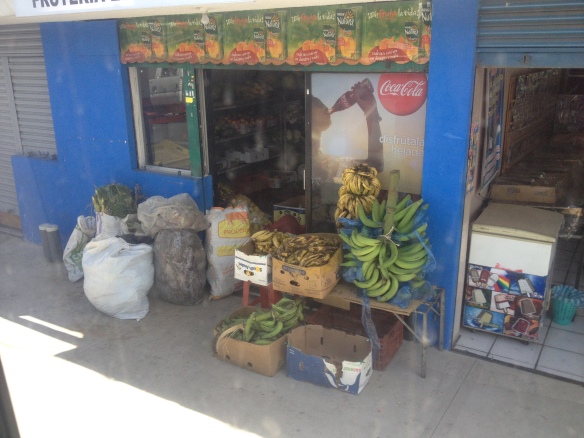
Typical store front that one sees frequently in Ecuador. Every one seemed to have bananas hanging in front. Notice the bag of pig feed in the front door. 1/3 to half of the pigs are raised in the backyard.
Because many people buy their food daily from these small storefronts, it’s difficult to provide additional food choices. At the facility that we visited that does meat processing they talked about that at the few larger grocery stores in the cities that they actually provide refrigeration for their products.
The second most consumed meat in Ecuador is pork. As recently as 2007, 50% of the pork was raised in backyard production. As someone who was raised on a hog farm, that seems very challenging!
Although we did not see any areas that were high production areas for corn, we were told that Ecuador’s goal is to be self sufficient in corn production. The only corn that we saw were small patches planted near houses in an area the size of a large backyard. That corn was surely hand planted and the plants appears to be a few feet apart, much different than our fields where corn plants are about 6 inches apart!
It was very interesting to see how the Ecuadorians purchase food compared to the U.S. I appreciate my refrigerator and opportunity to grocery shop once per week even more after seeing how they must purchase food. The reality is I could probably go a month (maybe more) without grocery shopping, where many of these folks literally might not eat that night without working for that day’s wages.
Will Ecuador be the Future Aquaculture Center of the World? – Part 3
Guayaquil, Ecuador was our next stop after Panama. The population of Guayaquil is similar to Chicago at 2.7 million people. Guayaquil is located on the western coast of Ecuador.
Shrimp Farm Tour – Ecuador is well known for its aquaculture production. In particularly, they produce a large quantity of shrimp, tilapia, and tuna. We had the opportunity to visit a shrimp farm and a feed mill that produces food for shrimp.
The shrimp farm that we visited was around 690 acres, and the field (or pond) that we were at appeared to be around 5 acres. For reference, an acre is about the same size as a football field. This farm fed their shrimp two times per day. They find that the shrimp do better being fed fresh twice a day rather than being continuously fed. The employees monitor the oxygen in the water several times per day.
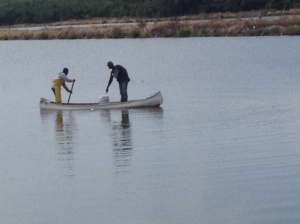
The employees showed us how they feed the shrimp. There are feeders under the water that are pulled up and they manually fill them.
This shrimp farm was located fairly far away from a community so there were dorms on site. The employees live on site for 11 days then return home for 4 days. I understood that 30-40% of the shrimp is exported to the U.S. The farm is paid for the shrimp on a per pound basis, and the managers told us they prefer to sell the shrimp with their heads as they can capture more money per shrimp.
Harvesting shrimp – We did not actually see the harvesting process, but this was my understanding of how the shrimp are harvested. It is a several hour process to harvest as the pond must be drained. The drains are covered with netting. As the water drains, the shrimp move with the water to one area of the pond. The shrimp are then collected in nets and shipped out to a processing facility in refrigerated trucks.
Feed Mill Tour – We were also able to tour a feed mill that makes feed (or food) for shrimp, as well as other animals. The feed mill was very modern, and looked similar to feed mills that I’ve been through in the U.S. They had similar safety precautions that one would see in a U.S. facility. One thing that was interesting to me was that we noticed a lot of landscaping at this plant. The tour guide said that there is a mandate for 10% green space, and this plant chose to do landscaping which was very appealing.
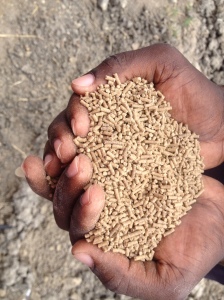
Feed (food) for shrimp
Several customers that we met with in Ecuador consistently said that they have a preference for U.S. soymeal. They mentioned that U.S. soymeal has a consistent quality, and there is a freight advantage out of the U.S. to Ecuador. It takes 8-10 days to ship U.S. soymeal from the Gulf of Mexico to Ecuador (the variance of time depends upon how long it takes the ship to go through the Panama Canal). However, most expect the shipment time to be reduced by one day once the Panama Canal expansion is complete. It takes about 18 days to ship out of the Argentine port. The buyers explained that the soy from Brazil and Paraguay will ship down the Parana River to the port in Argentina, similar to how grain is shipped down the Mississippi River to New Orleans for export out of the Gulf of Mexico.
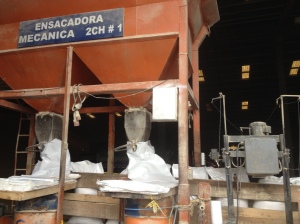
Bagging machine to bag soymeal. The soymeal can either be shipped by bulk in trucks or in individual bags.
We visited Andipuerto Terminal Port which is the bulk port. {If you recall, in Panama we visited a container port.} The main difference between this port and one in the U.S. has to do with the labor availability. In Ecuador there are many people so rather than putting in a conveyor system to move the bulk product (like a U.S. facility would), they unload onto trucks which transfer the product from the ship to the storage facility. With all of that truck traffic, it makes me wonder how many accidents and down time they have. My brother is a diesel mechanic, so I was interested to learn that their on-site mechanics all must go through a Caterpillar certification process.

Trucks used at the port
Next Stop – Quito, Ecuador the mountainous region
Trip Through the Panama Canal – Part 2
After touring a few agriculture sights in St. Louis, we were off to Panama to see the Panama Canal. The Panama Canal is very important to importing and exporting from the United States. The Canal allows ships to travel between the Atlantic and Pacific Oceans without having to travel around South America. This cuts significant time and cost off of transporting goods in and out of the U.S.
We visited during the 100 year anniversary of the Panama Canal’s completion. Currently, there are two lanes for the canal, and there is an expansion which will be done in the near future. This expansion will allow for bigger ships to pass through with the ultimate goal of shipping more freight at one time. It’s also estimated to cut shipping time down because ships will have to wait less time for their turn to go through the locks (kind of like have more lines open when checking out at the store).
Fun tidbits – Each year it rains 90″ on one side of the canal and 120″ on the other side this allows for enough water for the canal to properly function. In Panama, there’s an area where the sun rises over the Pacific Ocean rather than the Atlantic (look at a globe and try to wrap your mind around that!).
The first evening, we had the chance to see ships go through the locks. The locks work similar to the ones on the Mississippi River. This is a link to the History Channel of how the Panama Canal and how the locks work.
The next day, we took a ride along a section of the Panama Canal. Once we got to the locks, it was a game of ‘hurry up and wait’. To maximize the use of the locks, as many large boats and ships as can fit move through the lock at one time. Our tour boat would make it to the next gate while the ship that traveled behind us through the locks moved slowly. We went through a total of 3 locks.
The largest ships that can go through the original Canal are called Panamax ships. They are as wide as the Canal can handle (I believe leaving only 12” on each side) and draft as deep as possible when loaded. Grain shipped out of the Gulf of Mexico is often loaded on Panamax ships.
The second tour we had was the Port of Balboa. This port is a major employer, employing about 5,000 people. The Port of Balboa handles millions of containers each year. Containers are used to ship goods in and out of the U.S. For example, China loads containers with electronics to be shipped to the U.S.
The Panamanians understand what an incredible opportunity the Canal is for the economy of their country. From what our tour guide shared with us, there is a shift to make Panama a destination spot. The area where we stayed was very modern with a lot of construction of high rises and walking paths.
We had a few minutes to pick up souvenirs before heading to the airport. The Latin American woman who was traveling with us told me that the pattern of the lines sewn on are a sign of true Panamanian.
This visit to Panama piqued my interest in understanding the history of Panama better. I want to go back and study the U.S. military presence in Panama and how the Panama Canal operations were turned over to the Panamanians. After driving by the prison where Manuel Noriega is currently being held, I want to understand his influence better. In current news, Noriega recently filed a lawsuit against the makers of the “Call of Duty” games for using his image.
Next stop – Guayaquil, Ecuador
Why go to Panama & Ecuador? – Part 1
It’s an odd feeling to know that I’m about to embark on a journey that I know is going to be life changing. I don’t really know how exactly, but I am confident that it will be life changing. Prior to this trip, Canada was the extent of my international travels, and that was before 9-11 when one only needed a copy of their birth certificate to cross the border.
How in the world does someone who did not have a passport 6 months ago end up traveling to Panama and Ecuador? It all started last spring when a friend shared that there was an opportunity for farmers to apply for the See for Yourself program.
This is the seventh annual See for Yourself program that the United Soybean Board (USB) oversees. USB is like the national soybean board which, according to the USB website ”administers soybean checkoff activities focusing on research and market development and expansion.”
Each year, there are 10 farmers who are selected to participate in the See for Yourself program. I am honored to have been chosen to participate this year. I am anxious to meet the other farmers and learn more about how USB works. I’m particularly interested in gaining a deeper understanding of how markets are developed for U.S. soybean farmers.
To fully understand my interest in this program, it’s helpful to understand some of my background.
Way back when, I worked for an international grain and food company. My first job with this company was in the grain division working in Washington State. I was stationed at a grain elevator along the Columbia River. Our elevator handled wheat – three different kinds!
Where I worked, all the wheat that was delivered to us was loaded onto barges and sent to Portland, OR to then be loaded onto ships and exported to other countries. Most of the wheat we handled eventually ended up in the Pacific Rim countries.
Being part of the process of seeing the wheat grow, harvested, and eventually shipped to other parts of the world was fascinating. I learned how the international buyers buy grain and how the pricing structure works – there’s the price here in the U.S. and how competitive that is compared to other countries trying to sell their own grain plus what is the cost of transportation across the U.S. not to mention the international shipping rates. It’s a little bit like a puzzle with lots of pieces.
The barges that we loaded in Washington held anywhere from 65 to 110 semi truck loads of grain. The barges were sent down the Columbia River to Portland, OR. Each barge that we sent to Portland was offloaded to a terminal elevator for temporary storage until being reloaded onto the ship. Each international buyer has specifications that they require the grain to meet.
While I was stationed in Washington, I had to opportunity to spend a two weeks at one of my company’s shipping terminals in Portland, and learn how ships are loaded. There are financial penalties charged (demurrage) if the ships aren’t loaded quickly enough. Samples are taken throughout the loading process and every several thousand bushels that are loaded are checked to ensure that the overall ship load will meet the buyer’s specifications.
Being on a grain ship was amazing. Some of the stories that the crew and the old timers told were fascinating, and some seemed a little far-fetched 🙂
Fast forward to today, no longer in the Pacific Northwest near where ships are loaded and sent to faraway countries. Today, some of the corn and soybeans raised on our farm go to the grain elevators in Topeka, KS. {See my post from September 21, 2012 about where all of our grain is shipped to.} Part of the grain that is in the elevators in Topeka is shipped by rail to the Gulf of Mexico to be loaded onto ships and exported to other countries. Many of those ships go through the Panama Canal – which is one of the highlights on this trip that I’m about to embark upon.
So that’s a little bit of my background, from my past work experience of learning how international grain buyers buy U.S. grain and loading ships to where my own farm’s grain may end up on a ship at the Gulf of Mexico. This all leads to why I am interested in learning more about how the United Soybean Board helps to develop markets for U.S. farmers. I’m excited to be participating!

